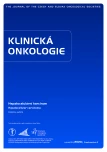Hepatocellular carcinoma – imaging methods and imaging guided therapy
Authors:
prof. MUDr. Ferda Jiří, Ph.D. 1; MUDr. Ferdová Eva 1; doc. MUDr. Mírka Hynek, Ph.D. 1; Duras Petr 1; prof. MUDr. Fínek Jindřich, Ph.D. 2
Authors‘ workplace:
Klinika zobrazovacích metod LF UK a FN Plzeň
1; Onkologická a radioterapeutická klinika LF UK a FN Plzeň
2
Published in:
Klin Onkol 2020; 33(Supplementum 3): 5-12
Category:
Review
doi:
https://doi.org/10.14735/amko20203S5
Overview
The imaging modality choice depends on the clinical question in hepatocellular carcinoma (HCC); when HCC is suspected, then ultrasound serves as imaging at the first line, followed by computed tomography. When specialized differential diagnosis or biological behaviour of HCC is a clinical issue, magnetic resonance imaging with a use of hepatospecific contrast agent or hybrid imaging using positron emission tomography and computed tomography or positron emission tomography and magnetic resonance imaging with the application of 18F-fluorodeoxglucose or 18F-fluorocholine are exploited. In the therapy of HCC, it is possible to use locally destructive methods of interventional radiology, especially radiofrequency ablation or transarterial chemoembolization, or radioembolization, as the case may be.
Keywords:
hepatocellular carcinoma – magnetic resonance imaging – computed tomography – Positron emission tomography – hybrid imaging methods
Sources
1. Murakami T, Kim T, Takamura M et al. Hypervascular hepatocellular carcinoma: detection with double arterial phase multi-detector row helical CT. Radiology 2001; 218 (3): 763–767. doi: 10.1148/radiology.218.3.r01mr39763.
2. Tajima T, Honda H, Taguchi K et al. Sequential hemodynamic changes in hepatocellular carcinoma and dysplastic nodules: CT angiography and pathologic correlation. Am J Roentgenol 2002; 178 (4): 552–554. doi: 10.2214/ajr.178.4.1780885.
3. Ferda J, Mírka H, Třeška V et al. Diagnostika hepatocelulárního karcinomu dvoufázovou výpočetní tomografií, porovnání přínosu dvouřadého a šestnáctiřadého výpočetního tomografu. Čes Radiol 2003; 57 : 319–324.
4. Delbeke D, Martin WH, Sandler MP et al. Evaluation of benign vs malignant hepatic lesions with positron emission tomography. Arch Surg 1998 : 133 (5): 510–515. doi: 10.1001/archsurg.133.5.510.
5. Khan MA, Combs CS, Brunt EM et al. Positron emission tomography scanning in the evaluation of hepatocellular carcinoma. J Hepatol 2000; 32 (5): 792–797. doi: 10.1016/s0168-8278 (00) 80248-2.
6. Okazumi S, Isono K, Enomoto K et al. Evaluation of liver tumors with fluorine-18-fluorodeoxyglucose PET: characterisation of tumor and assessment of effect of treatment. J Nucl Med 1992; 33 (3): 333–339.
7. Lee JD, Yun M, Lee JM et al. Analysis of gene expression profiles of hepatocellular carcinomas with regard to 18F-fluorodeoxyglucose uptake pattern on positron emission tomography. Eur J Nucl Med Mol Imaging 2004; 31 (12): 1621–1630. doi: 10.1007/s00259-004-1602-1.
8. Talbot JN, Gutman F, Fartoux L et al. PET/CT in patiens with hepatocellular carcinoma using [18F] fluorocholine: preliminary comparison with [18F] FDG PET/CT. Eur J Nucl Med Mol Imaging 2006; 33 (11): 1285–1289. doi: 10.1007/s00259-006-0164-9.
9. Ferda J, Ferdová E, Baxa J et al. The role of 18F-FDG accumulation and arterial enhancement as biomarkers in the assessment of typing, grading and staging of hepatocellular carcinoma using 18F-FDG-PET/CT with integrated dual-phase CT angiography. Anticancer Res 2015; 35 (4): 2241–2246.
10. Mirka H, Duras P, Baxa J et al. Contribution of computed tomographic angiography to pretreatment planning of radio-embolization of liver tumors. Anticancer Res 2018; 38 (7): 3825–3829. doi: 10.21873/anticanres.12666.
11. Liu DM, Salem R, Bui JT et al. Angiographic considerations in patients undergoing liver-directed therapy. J Vasc Interv Radiol 2005; 16 (7): 911–935. doi: 10.1097/01.RVI.0000164324.79242.B2.
12. Salem R, Thurston KG, Carr BI et al. Yttrium-90 microspheres: radiation therapy for unresectable liver cancer. J Vasc Interv Radiol 2002; 13 (9 Pt 2): S223–S224.
13. Coldwell D, Sangro B, Wasan H et al. General selection criteria of patients for radioembolization of liver tumors: an international working group report. Am J Clin Oncol 2011; 34 (3): 337–341. doi: 10.1097/COC.0b013e3181ec61bb.
14. Maleux G, Heye S, Vaninbroukx J et al. Angiographic considerations in patients undergoing liver-directed radioembolization with 90Y microspheres. Acta Gastroenterol Belg 2010; 73 (4): 489–496.
15. Dezarn WA, Cessna JT, DeWerd LA et al. Recommendations of the American Association of Physicists in Medicine on dosimetry, imaging, and quality assurance procedures for 90Y microsphere brachytherapy in the treatment of hepatic malignancies. Med Phys 2011; 38 (8): 4824–4845. doi: 10.1118/1.3608909.
Labels
Paediatric clinical oncology Surgery Clinical oncologyArticle was published in
Clinical Oncology

2020 Issue Supplementum 3
- Metamizole at a Glance and in Practice – Effective Non-Opioid Analgesic for All Ages
- Possibilities of Using Metamizole in the Treatment of Acute Primary Headaches
- Metamizole in perioperative treatment in children under 14 years – results of a questionnaire survey from practice
- Safety and Tolerance of Metamizole in Postoperative Analgesia in Children
- Obstacle Called Vasospasm: Which Solution Is Most Effective in Microsurgery and How to Pharmacologically Assist It?
Most read in this issue
- Hepatocellular carcinoma future treatment options
- Current treatment options for hepatocellular carcinoma
- Hepatocellular carcinoma – imaging methods and imaging guided therapy
- Hepatocellular carcinoma from the view of gastroenterologist/hepatologist
